CHEMISTRY GLOSSARY
Pipeline to Success:
Your Guide to Pipeline Remediation Chemistry with Ideal Energy Solutions
WHITE PAPER
Work Greener,
Not Harder
New advancements in green chemistry prove successful in the oil and gas industry
Ready to become an oilfield chemistry expert?
Look no further than the Ideal Energy Solutions LLC Chemistry Glossary: The complete guide to pipeline remediation chemistry has got you covered.
Discover the secrets of our proprietary Green Seal Certified®, PipeRenew® and WellRenew® treatments, which neutralizes paraffin and asphaltene stickiness, breaks apart wax solids with a proprietary blend of environmentally responsible surfactants, and leaves a protective barrier on pipe walls that sticky paraffins and asphaltene are unable to stick to. From remediation to prevention maintenance solutions, we’ve got all the pipeline chemistry terms you need to make a big impact.
Whether you prefer to view it online or download it for later, our comprehensive guide is at your fingertips. Become the go-to person for all things flow assurance and impress your friends (and maybe even your boss) with your newfound knowledge.
Download the full Glossary:
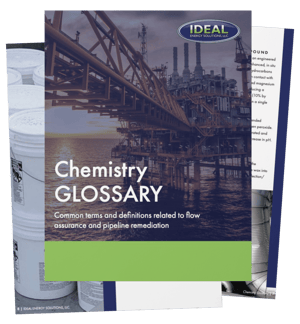
During crude oil production and transportation, certain hydrocarbon properties and operating conditions can result in the formation and deposition of undesired solids in pipelines well. Buildup of these solids on pipe walls can plug the pipe or downhole tubular and hinder flow.
Flow Assurance is a cost-effective approach to mitigating solids buildup and minimizing economic risks from reservoir to refinery. Below, we have listed and defined some of the most common terms related to chemical pipeline remediation technology.
List of Terms
Adhesion
Alkaline Cleaner
Aromatics / Aromatic Compounds Asphaltenes
BTEX Free
Chemical Wax Inhibitors
Cloud Point
Controlled Oxygen Release Crystallization
Detergents
Dynes
Emulsification
Flow Assurance
Hydrophilic-Lipophilic Balance
Inorganic Solvents
Laminar Flow
Line Heating
Miscibility
Open-Chain Saturated Hydrocarbons
Oxygen Release Compound
Oxygenated Alkaline Composition Paraffin
Paraffin Inhibitors
Paraffin Wax
Peroxygen
Saponify / Saponification
Solvent
Surface Tension
Surfactant
Wax Appearance Temperature
Wax Inhibitor / Paraffin Inhibitor
Zeta Potential
A
ADHESION
Adhesion is the attraction between two dissimilar phases. There is no single theory to explain adhesion, but it is commonly divided into mechanical interlocking and physical and chemical bonding.
The adhesion of paraffin/asphaltene deposits resembles a static charge where the deposit is attracted to the pipe wall. This charge is prevalent with hydrocarbons having a carbon chain higher than 16. It is these higher carbon chains that start and make up the majority of the pipeline plugs.
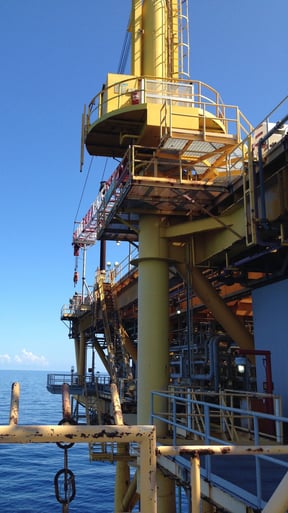
NOTE: WellRenew® and PipeRenew® are considered to be alkaline cleaners because their pH is above 8. The main alkalinity components are sodium carbonate (soda ash) and sodium metasilicate. Sodium metasilicate reacts with the fatty acid found in oil and acts as a corrosion inhibitor by depositing a microscopic silica film on pipe walls which helps prevent further paraffin/asphaltene deposits.
AROMATICS/AROMATIC COMPOUNDS
Aromatics are a type of organic compound that have joining bonds. These compounds are characterized by enhanced stability of chemicals, and result from electron delocalization within a ring system that typically contains several conjugated binary bonds. Examples of aromatics include toluene, benzene and xylene.
ASPHALTENES
Asphaltenes are the nonpolar and nonvolatile components of crude oil. They are a complex
organic matter made of a variety of alkane, alkene hydrocarbons and fatty acids. Asphaltenes are insoluble in alkanes (normal pentane and normal heptane) but soluble in aromatics (benzene and toluene). The fatty acids react with alkaline detergent to form a simple soap. During the reaction, a compound is formed that acts as a lubricant and a dispersant which helps in the removal of plugs.
B
BTEX FREE
BTEX free is a term used to describe solvent such as aromatics that are free of Benzene, Toluene, Ethylbenzene and Xylene. BTEX solvents are known to cause cancer, so hydraulic fracturing fluids must not contain BTEX.
C
CHEMICAL WAX INHIBITORS
Chemical wax inhibitors such as pour point depressants and wax dispersants are used to chemically modify the wax solid structure thus reducing the tendency of the wax crystals to interlock and form three-dimensional network growths. The main function of wax inhibitors is to impede paraffin growth. However, these wax inhibitors do not stop the waxing process, but delay the precipitation and hardening process, thus allowing the wax aggregates to be swept away in the oil production steam flow.
CLOUD POINT
Cloud point is the temperature at which a solution of a surfactant begins to agglomerate on a molecular level, generating a cloudy physical appearance. Cloud point temperatures are important for liquid fuels and other petroleum-based substances. If the temperature of
flowing oil drops below this point, paraffin components begin to crystallize into solid wax.
NOTE: Our proprietary Green Seal® certified PipeRenew® and WellRenew® treatments modify the carbon chains to change their physical appearance, reducing sticking and in some cases lowering the cloud point of the oil. This lowers the temperature at which paraffin begins to accumulate on the pipeline walls.
CHRYSTALLIZATION
Crystallization is a natural process in which materials solidify from a liquid or precipitate out of a liquid or gas. This is caused by a physical change such as a temperature change, or by a chemical change such as a change in acidity.
CONTROLLED OXYGEN RELEASE
The controlled release of oxygen is very important in neutralizing a static charge that occurs when produced water and oil are mixed in a non-laminate flow. The release of the oxygen over a long period of time allows WellRenew® and PipeRenew® to travel the entire length of a pipeline plug and neutralize the charge.
D
DETERGENTS
Detergents are non-soap cleaning agents. Surfactants are detergents that will modify the surface activity of water allowing it to penetrate soils and saponify oils to mix with water.
DYNES
Dynes are a unit of measurement used to determine the surface energy of a film or foil. Standard tap water had a dyne count of 76 and seawater has 78-80 dynes.
NOTE: Our advanced proprietary flow assurance products like PipeRenew® and WellRenew® have an extremely low surface tension of around 20 dynes, making them very “skinny”, and thus allowing them to easily navigate through tight cracks and crevices within blockage, and between the blockage and pipeline wall.
E
EMULSIFICATION
Emulsification is the process of mixing two immiscible liquids like oil and water. One of the liquids gets dispersed as small droplets within the other. There are two types of emulsifications: oil in water (normally clear) and water in oil (normally white-cloudy).
F
FLOW ASSURANCE
Flow assurance is the process of mitigating restrictions in pipelines to maintain production and flow of hydrocarbons.
G
GREEN SEAL® CERTIFIED
Green Seal® is a nonprofit organization that certifies products according to their rigorous standards for environmental, health, sustainability and product performance. The certification validates a company’s sustainability leadership so consumers can trust that they are purchasing healthy and green products. PipeRenew® and WellRenew® are both Green Seal® certified.
H
HYDROPHILIC-LIPOPHILIC BALANCE (HLB)
Hydrophilic–lipophilic balance (HLB) is the balance of the size and strength of the hydrophilic and lipophilic moieties of a surfactant molecule.
The hydrophilic–lipophilic scale is divided into three parts. Surfactants from 1-4 are oil-loving and oil-soluble; 8-14 are water-loving and soluble in water; and 5-7
are both water- and oil-loving. Experts mix and match different types of surfactants to enhance performance of a detergent.
I
INORGANIC SOLVENTS
Inorganic solvents are those that do not contain carbon. Examples include water, ammonia, carbon dioxide, carbon tetrachloride, hydrogen fluoride, molten salt, and sulfuric acid.
L
LAMINAR FLOW
Laminar flow describes a fluid that flows in parallel lines or in a steady flow. Non-laminar flow is turbulent where the fluid moves in different directions (examples: mixing or pumping of liquids).
LINE HEATING
Line heating is a technique used to prevent hydrate formation in pipe.
M
MISCIBILITY
Miscibility is the process by which two liquids completely mix together. For example, when mixing any amount of water and ethanol, the result will always be a clear, colorless liquid like the original components.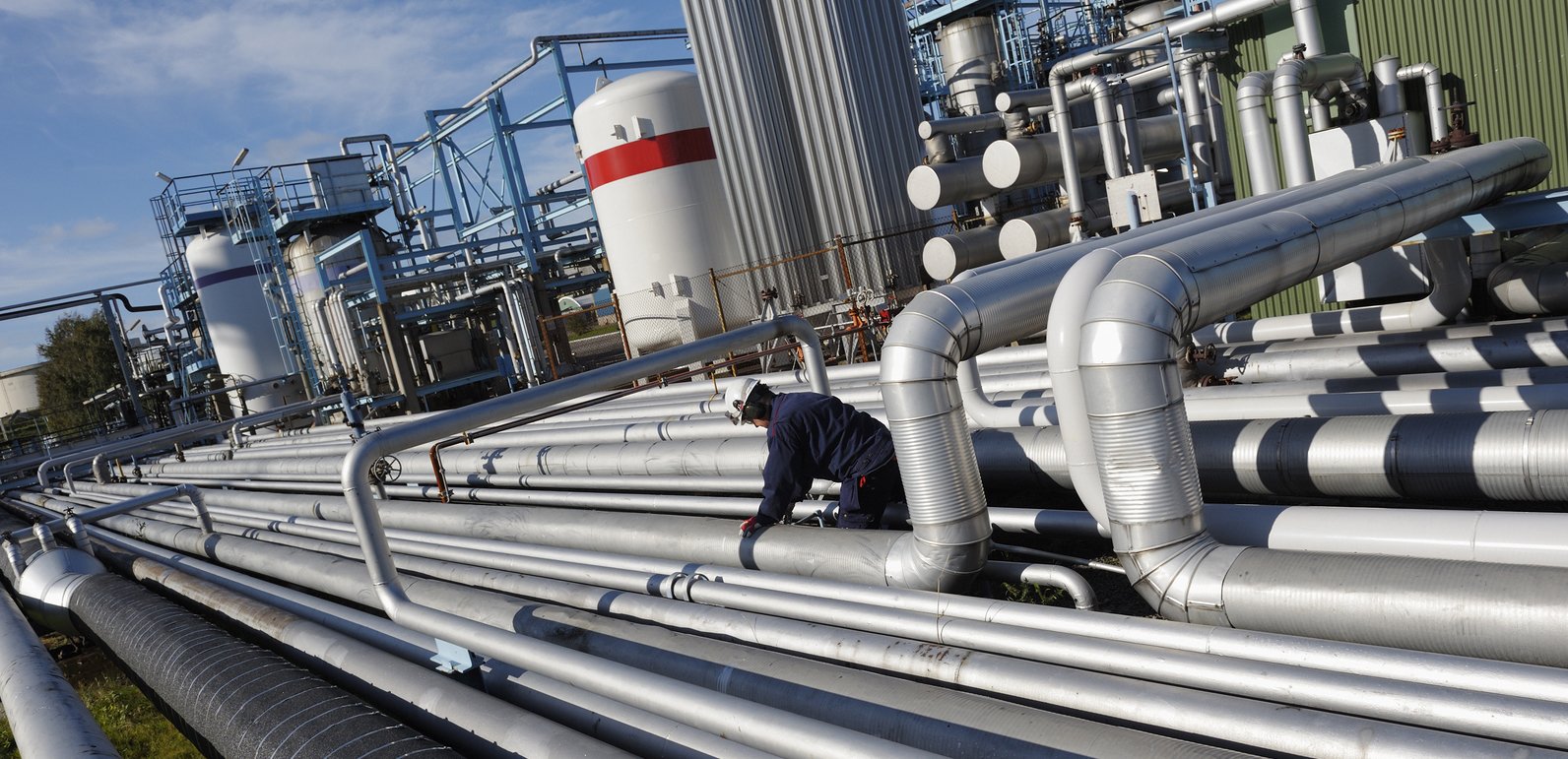
O
OPEN-CHAIN SATURATED HYDROCARBONS
Open-chain saturated hydrocarbons are organic compounds with a linear, open structure that does not form a ring. These compounds are non-aromatic.
OXYGEN RELEASE COMPOUND
Oxygen Release Compound (ORC) is an engineered compound designed specifically for enhanced, in situ aerobic bioremediation of petroleum hydrocarbons in groundwater or saturated soils. Upon contact with groundwater, this phosphate-intercalated magnesium based material becomes hydrated producing a controlled-release of molecular oxygen (10% by weight) for periods of up to 12 months on a single application.
We use sodium percarbonate ORC, a blended material containing soda ash and hydrogen peroxide. Oxygen is released when the ORC is hydrated and hydrogen peroxide is released with an increase in pH.
OXYGENATED ALKALINE COMPOSITION
Oxygenated alkaline compositions act on the adhesion intrinsic to paraffin, dislodging the wax into pieces that can flow out of pipelines for collection/disposal.
P
PARAFFIN
Paraffin is a catch-all term for all alkanes, including methane, waxes, asphaltenes and long-chain hydrocarbons that have condensed and plated out inside downhole production equipment.
PARAFFIN INHIBITORS
Paraffin inhibitors are chemical treatments that prevent wax from being deposited in pipelines. They modify the shape and size of wax crystals and disperse the paraffin back into the oil to ensure steady flow.
PARAFFIN WAX
Paraffin wax is a soft, colorless solid derived from petroleum, coal or oil shale that consists of a mixture of hydrocarbon molecules containing 20 to 40 carbon atoms.
NOTE: WellRenew® is the only non-hazardous, environmentally responsible remediation solution in existence that effectively removes paraffin wax and asphaltenes in wellbore tubulars. PipeRenew® is the only non-hazardous, environmentally responsible remediation solution in existence that effectively removes paraffin wax and asphaltenes in pipelines.
PEROXYGEN
Peroxygens are strong oxidizing agents that can be used for in situ chemical oxidation. One of the most widely used peroxygen is hydrogen peroxide (H2O2).
S
SAPONIFY/SAPONIFICATION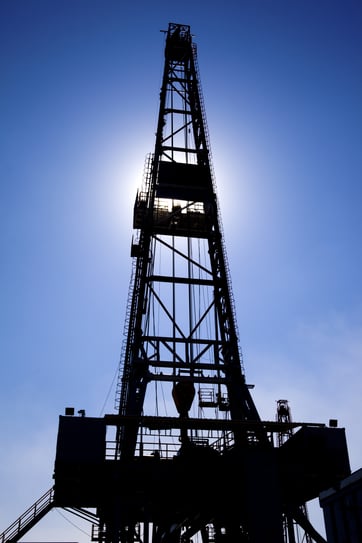
Saponification is the process of hydrolyzing a fat, oil or lipid with alkali to form a soap and glycerol.
SOLVENT
A solvent is a substance that dissolves a solute, resulting in a solution. Solvents are usually liquid, but can be a gas, solid or supercritical fluid. The amount of a solvent required to dissolve a solute depends on temperature and the presence of other substances in a sample.
NOTE: The PipeRenew® chemical remediation solution is temperature- independent. Unlike solvents,
subsea temperatures of 34°F or less do not affect its ability to remove paraffin, asphaltenes, or mineral scales.
SURFACE TENSION
Surface tension is the property of a liquid that allows it to resist external forces at the air-liquid interface. Liquid surfaces at rest tend to shrink into the minimum surface area possible, allowing objects with densities greater than water to float
on a surface without becoming submerged (for example, an insect floating on water).
NOTE: PipeRenew® is a proprietary granular product blend which contains surfactants and encapsulated oxygen and is water soluble. The product can be blended/activated on-site with any source of water available, such as fresh water, salt water or produced water.
SURFACTANT
Surfactants are substances that create self-assembled molecular clusters called micelles in a solution (water or oil phase) and adsorb to the interface between a solution and a different phase (gasses/solids).
NOTE: Surfactants such as our proprietary PipeRenew® and WellRenew® treatments lower surface tension, restoring pipeline flow by eliminating the stickiness between the blockage and the pipeline wall.
W
WAX APPEARANCE TEMPERATURE
Wax Appearance Temperature (WAT), also known as Wax Precipitation Temperature (WPT), is the cloud point of crude or heavy oils. It is the temperature at which a mixture starts to phase separate and two phases appear, causing the mixture to become cloudy.
WAX INHIBITOR/PARAFFIN INHIBITOR
A wax or paraffin inhibitor is a chemical injected into the pipeline or wellbore to prevent or minimize paraffin deposition.
Z
ZETA POTENTIAL
Zeta potential is a physical property which is exhibited by any particle in suspension, macromolecule or material surface. It can be used to optimize the formulations of suspensions, emulsion and protein solutions, predict interactions with surfaces, and optimize the formation of films and coatings.
Knowledge of the zeta potential in the formation of pipeline deposits was the key in the development of WellRenew® and PipeRenew®
Founded in 2013, Ideal Energy Solutions, LLC is a technology service company based in Lafayette, Louisiana. We specialize in the development of flow assurance and production maintenance chemicals for the oil and gas industry, serving onshore and offshore operations throughout South Louisiana, the Gulf Coast, South Texas and international markets.
The diverse professional experience of our team of engineers, chemists, supervisors and technicians supplies the knowledge needed to develop new processes and formulas to ensure the flow of hydrocarbons from the reservoir to the refinery. Our commitment to keeping workers safe, property undamaged, and the environment unharmed has led us to create some of the most environmentally responsible pipeline remediation solutions on the market.
Thank you for reading! Take this Glossary with you:
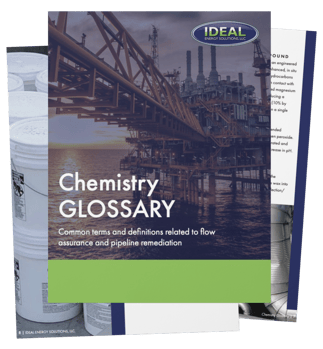
.png?width=261&height=101&name=ideallogo2%20(2).png)